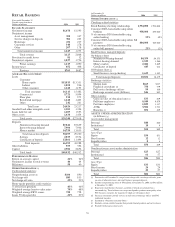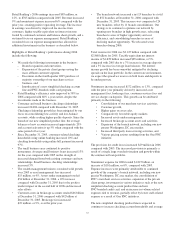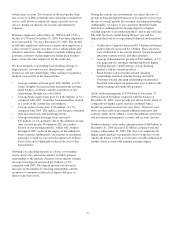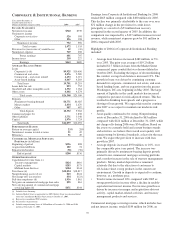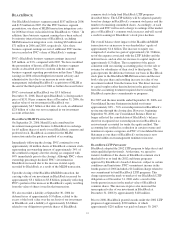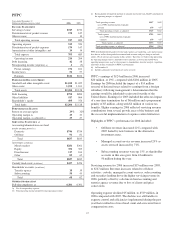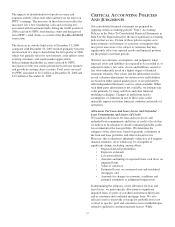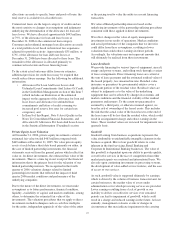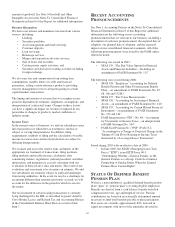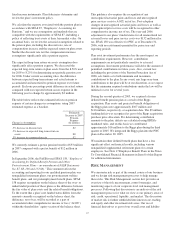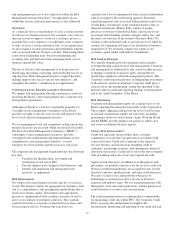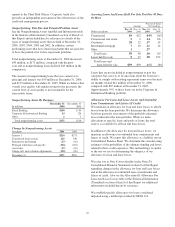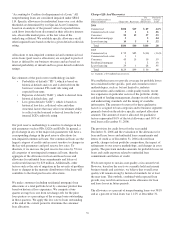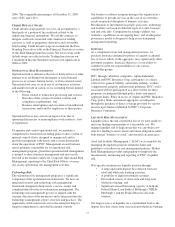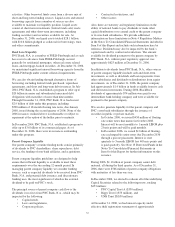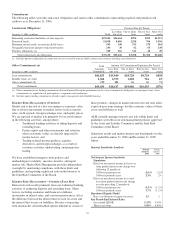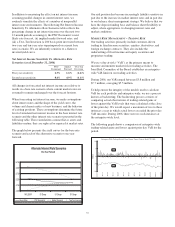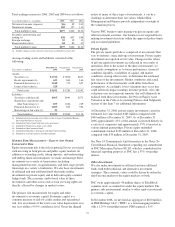PNC Bank 2006 Annual Report Download - page 56
Download and view the complete annual report
Please find page 56 of the 2006 PNC Bank annual report below. You can navigate through the pages in the report by either clicking on the pages listed below, or by using the keyword search tool below to find specific information within the annual report.amount of goodwill. See Note 9 Goodwill and Other
Intangible Assets in the Notes To Consolidated Financial
Statements in Item 8 of this Report for additional information.
Revenue Recognition
We derive net interest and noninterest income from various
sources, including:
• Lending,
• Securities portfolio,
• Asset management and fund servicing,
• Customer deposits,
• Loan servicing,
• Brokerage services,
• Merger and acquisition advisory services,
• Sale of loans and securities,
• Certain private equity activities, and
• Securities and derivatives trading activities including
foreign exchange.
We also earn fees and commissions from issuing loan
commitments, standby letters of credit and financial
guarantees, selling various insurance products, providing
treasury management services and participating in certain
capital markets transactions.
The timing and amount of revenue that we recognize in any
period is dependent on estimates, judgments, assumptions, and
interpretation of contractual terms. Changes in these factors
can have a significant impact on revenue recognized in any
period due to changes in products, market conditions or
industry norms.
Income Taxes
In the normal course of business, we and our subsidiaries enter
into transactions for which the tax treatment is unclear or
subject to varying interpretations. In addition, filing
requirements, methods of filing and the calculation of taxable
income in various state and local jurisdictions are subject to
differing interpretations.
We evaluate and assess the relative risks and merits of the
appropriate tax treatment of transactions, filing positions,
filing methods and taxable income calculations after
considering statutes, regulations, judicial precedent, and other
information, and maintain tax accruals consistent with our
evaluation of these relative risks and merits. The result of our
evaluation and assessment is by its nature an estimate. We and
our subsidiaries are routinely subject to audit and challenges
from taxing authorities. In the event we resolve a challenge for
an amount different than amounts previously accrued, we will
account for the difference in the period in which we resolve
the matter.
Our tax treatment of certain leasing transactions is currently
being challenged by the IRS, as described in greater detail in
Cross-Border Leases and Related Tax and Accounting Matters
in the Consolidated Balance Sheet Review section of this
Item 7.
R
ECENT
A
CCOUNTING
P
RONOUNCEMENTS
See Note 1 Accounting Policies in the Notes To Consolidated
Financial Statements in Item 8 of this Report for additional
information on the following recent accounting
pronouncements that are relevant to our business, including a
description of each new pronouncement, the required date of
adoption, our planned date of adoption, and the expected
impact on our consolidated financial statements. All of the
following pronouncements were issued by the FASB unless
otherwise noted.
The following was issued in 2007:
• SFAS 159, “The Fair Value Option for Financial
Assets and Financial Liabilities – Including an
amendment of FASB Statement No. 115”
The following were issued during 2006:
• SFAS 158, “Employers’ Accounting for Defined
Benefit Pension and Other Postretirement Benefit
Plans – an amendment of FASB Statements No. 87,
88, 106 and 132(R)”
• SFAS 157, “Fair Value Measurements”
• SFAS 156, “Accounting for Servicing of Financial
Assets – an amendment of FASB Statement No. 140”
• SFAS 155, “Accounting for Certain Hybrid Financial
Instruments – an amendment of FASB Statements
No. 133 and 140”
• FASB Interpretation (“FIN”) No. 48, “Accounting
for Uncertainty in Income Taxes – an interpretation
of FASB Statement No. 109”
• FASB Staff Position No. (“FSP”) FAS 13-2,
“Accounting for a Change or Projected Change in the
Timing of Cash Flows Relating to Income Taxes
Generated by a Leveraged Lease Transaction”
Issued during 2005 with an effective date in 2006:
• In June 2005, the FASB’s Emerging Issues Task
Force (“EITF”) issued EITF Issue 04-5,
“Determining Whether a General Partner, or the
General Partners as a Group, Controls a Limited
Partnership or Similar Entity When the Limited
Partners Have Certain Rights”
S
TATUS
O
F
D
EFINED
B
ENEFIT
P
ENSION
P
LAN
We have a noncontributory, qualified defined benefit pension
plan (“plan” or “pension plan”) covering eligible employees.
Benefits are derived from a cash balance formula based on
compensation levels, age and length of service. Pension
contributions are based on an actuarially determined amount
necessary to fund total benefits payable to plan participants.
Plan assets are currently approximately 60% invested in
equity investments with most of the remainder invested in
46


